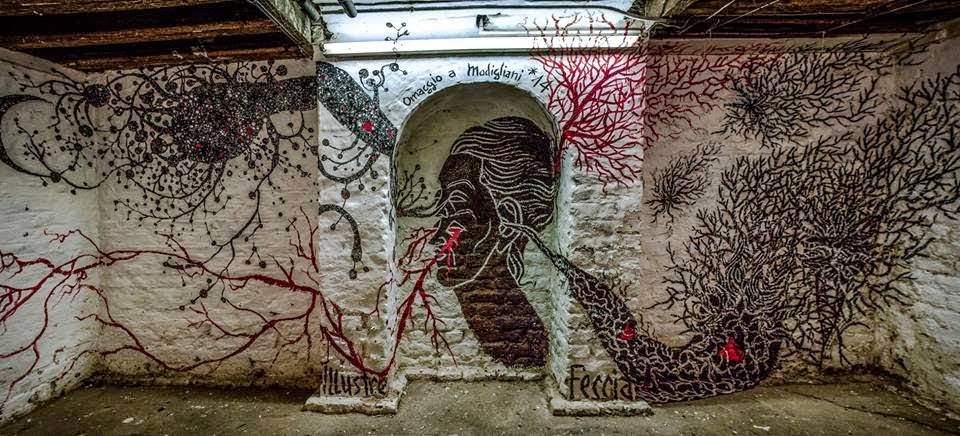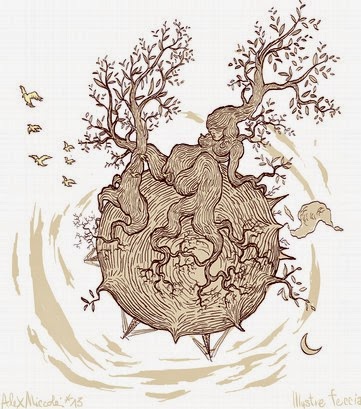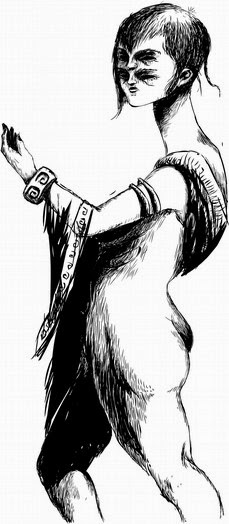IllustreFeccia is one of my friends. This is why it is quite difficult to
write about his work. We both gravitate around The Minesweeper
Collective. Both, I think, we find there what we seek: freedom
and open-mindedness, lined with dynamism and essential rigor that
usually are never conciled in a collective (and we have to pay
tribute to all those amazing people who welcomed us, including Camden
McDonald who initiated the project, Niccolo Bruni and Andrew The
Terror that support it daily head-on, and obviously Kevin Seven who
strives every moment to make it grow).
We are both
quite similar. Illustre Feccia is ambitious as I am; he is voluptuous
as I am, he can hardly bear annoyances and refuses absurd
constraints. He is sensitive. He is à fleur de peau
(on edge). In addition to having a boundless generosity, as Italians
often do.
Much has been
written in the few articles devoted to him about his influences and
references. It is quite clear that the punk universe, expressionism
(Beckmann, Grosz, etc.), H.R. Giger, are figureheads and a base
(that on which we rely, but also where we withdraw) for Illustre
Feccia. But I want to focus in this small study on the underground
movement of his artistic gesture.
I say gesture and I mean both the body mechanism in action (how? why?), but also, just a little behind, with the french feminine meaning of the word (la geste) which refers to an epic adventure, combat and (con)quest.
I say gesture and I mean both the body mechanism in action (how? why?), but also, just a little behind, with the french feminine meaning of the word (la geste) which refers to an epic adventure, combat and (con)quest.
« Undercurrents »
(plural form)
is the wonderful name given by the Minesweeper crew
to the gallery they
manage at the Bird’s
Nest, our favorite pub (the best) in
Deptford: The
Undercurrents Gallery. It is an ingenious
diversion – a step
aside – versus « underground », as the Minesweeper is
actually a boat… But
I like to interpret it – especially – just as a
movement
under the surface, under the mirror (more than
“behind”) under the tectonic plates.
And what comes to thrill the bark and the
skin…
The
artistic gesture is connected with the surface, of course, but it is
below references, culture, « ego » even
if it is excessive (« leaving
egos at the door …” we can read on the
website).
It is
this underground movement, which appears differently each time on
the surface, that is
important in what we see – in all that
we see.
And this
movement is fascinating in
Illustre Feccia‘s
works.
This is the line, – compulsive, generous, maniac (the mania is the dionysian madness that possessed bacchants), which just saturates the surface and inoculates it that expressive density. Since it is through this line, this abundance of features, that the movement arises.
Let’s
make that clear: this is not a mere
way of speaking. It is from the bottom
of the surface that the
gesture draws the traits that
emerge, protrude or spring on that surface.
It comes
from the lowlands, the underbelly,
from the
dregs and the grounds, which are
not really hidden, but dense enough that
nothing can be distinguished. Oil and tar.
That is also why what
gushes out is still
dark and stained by the expulsion gesture.
 |
| Mansuetudine Cristiana |
There is a clear maieutic-of-monstruosity process in Illustre Feccia‘s works. It is this process itself – the extraction of a hypogeal life – which is highlighted. It’s not the result that is shown, the dead foetus in its bath of formalin, the teratologic section of the museum, no, it is the whole operation of extirpation of the swarm, with a gap on the pluck, abundant flows, fluids and tissues, in addition to faces and monsters…
The
faces come from the bottom of the surface – canvas, paper or wall –
and they are projected
(or they project
themselves) to us, to
our own faces, with an almost violent
suddenness. With a closeness that is not only an effect of pictorial
spatiality, but also an inner proximity:
like magnets, attracting monsters in our very
inside (“Il
bambino che c’è in te”, “The
Babe that is inside you”). Illustre
Feccia draws depths and backs,
drags out the forces
and energies that move over there.
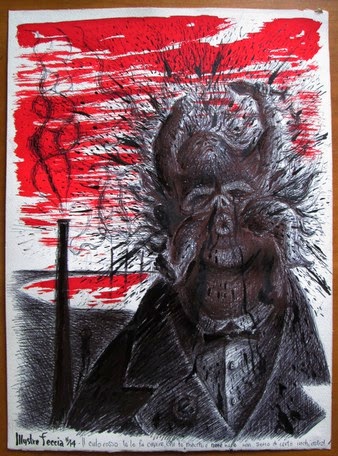 |
| Il bambino che c’è in te |
Its name, Illustre Feccia, somehow, echoes this. Illustre means light, lighting. Feccia refers to the vile matter, the dirty, the excrement (fex, fecis in latin), and that strikes the face – faeces hitting faces – the body and the intellect. It’s clandestine material.
Here, of course, we can connect the movement with its shape, the pattern and the theme, topics and references. It is expressionistic and it is punk. Revolt and social criticism of religions, finance, various coercive powers. This criticism works as a general denunciation of a world where many are starving when others stuff themselves, where free thought is if not punished at least limited, where we stop people from coming where we keep what we have stolen from them… This denunciation works as an extirpation and a highlighting of the profound forces, which are, after all, irrational. For it is irrational: the unreasoned energy (unreasonable?) that enables to prove undoubtedly that some socio-economic realities are unfair, everyone (yes, everyone) is aware of it, that many take offense about it, but finally it does not change and will never change anything (when we begin to want to reason about these unreasonable forces, when we try to reason them, we actually do politics; we don’t : we are in the city: we are politics). This irrational energy, inhuman energy (in the sense that it comes from the human but exceeds him, such as single bee and swarm function differently, or – if we want to divert a Platonic reference – that a limb can’t be compared to the whole body), this energy manifests and figures monsters. And these representations of monsters, (everybody will agree with me on that, at least) are a true treat.
But
before being political,
the remarks of Illustre
Feccia are
wider: the sensitivity
is involved, the
sensitivity of Being-in-the-world,
called – in philosophical
and (it must
be admitted… sorry…)
Heideggerian terms
– Dasein.
This is yet in another way, in a less superficial manner (how boring is this pseudo-political chatter in the deep squats!), that this gesture is political: through what we call « street art ».
Because the street art (in its best manifestations), we know, is the reclaiming of public space. The surface (the area) is large and flexible: it is no longer in his first architectural function (a wall, a door, a window, etc.), but it is diverted, re-appropriated, by humans. Better: it denounces the hypocrisy and cowardice that were used to build them. And so we can say Illustre Feccia pulls the monstruosity out of the walls.
Video by Jérémy La DjeyDje :
This is the immense work (Grand Œuvre) without lots of means. The artist is no longer limited to the frames, to the canvases, to what it costs (the work is also ephemeral and – more – difficult to recover), to the small surface to which it is constrained by lack of means. He no longer has to canvass the galleries and exhibition spaces, to corrupt himself: he can make the street his own gallery, as did Illustre Feccia under the arches of Deptford, following the Ha’penny Bridge. This may allow him to express himself according to his desire, without recourse to the institutions, without being stamped, retrieved, swallowed, and, in short, denied.
(video by Jérémy La DjeyDje)
But it would be simplistic to make Illustre Feccia‘s art an art of denunciation, an art – only – of protest (even « beautiful » or « well done ») and even a « dark » art. Since there is also humor, as in this sarcastic figure of a spaghetti eater, and seen that Illustre Feccia (who has lived in London for many years) is Italian, I am tempted to say a Pasolinian humor, or better yet a Boccacian humor, sarcastic and satirical, that delights, as in the Middle Ages, in the pretty vulgarities and beautiful profanities.
But I want to finish on one aspect of his work that I like a lot, which is quite rare and which has perhaps not been explored as well as others: delight & voluptous.
The first work of his I saw was a tribute to Modigliani, which repeated the figure of Luna Czeckowska (1919) that has long been (perhaps still is) my favorite figure by Modigliani (i felt straightaway a strong affinity between us). Her long neck and her blue eyes blurred by swoon…
It is still movement, not underground but submarine. Undercurrents less violent than in the « political » works – but just as intense. Scrolls and convolutions as they exist in beauty – that is pleasure and love. Here, art aspires to a certain harmony, which seeks to reinvent itself, made of nice quirks and intimate depths that flush, again, here and there, on the surface.
I say
surface but the
homage to Modigliani was painted in a basement
(in Palmerston squat in Deptford), which suited it
very well.
« Spring » (which also belongs to this rich magical vein in Illustre Feccia‘s works) is the individuation of this eroticism from the depths: a world of roots, a hypogeous world made monad, a planet (an absolute island) but also as a fragile bubble.
Ariane, in a more classical style, is the Ariane of the Labyrinth, that is to say, the corner, the hidden, the deep away, the Ariane of the « innermost » (« the most intimate, most secret, the deepest – the lower abdomen« ).
This highlightment (the exposure, the uncovering, the baring) is completely opposed to the Society of Spectacle analyzed by Debord and the Situationists. The projecting is opposed to the spectacular, the expression of inner experience is opposed to the entertainment as well as the cathartic event. You could say that we are dealing here with a surreptitious exposure, close to the unlawful, the illegal, the underground.
This is
where the art of Illustre Feccia is
valuable and worthy of admiration – beyond the friendship that is
sufficient in itself…
——–
Thanks to Emilie Huitric for the correction (& much more…)
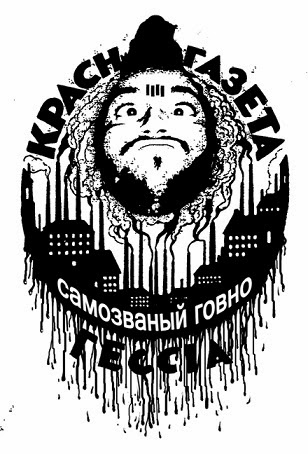


.jpg)
